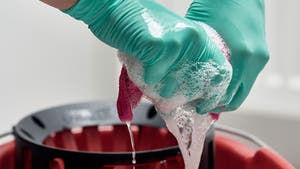More than 5,000 infection preventionists and healthcare professionals recently flocked to Philadelphia to attend the 46th Annual Conference of the Association for Professionals in Infection Control and Epidemiology (APIC).

With more than 270 exhibitors and over 100 sessions to choose from, it was a whirlwind of learning! Here is a summary of my top two takeaways from the sessions I attended:
1. No More CBIC Recertification Test
The best news of all came from the Certification Board of Infection Control & Epidemiology, Inc. (CBIC) on the first day of the conference. Roy Boukidjian, CBIC president, announced that beginning in 2020, recertification can be achieved through continuing education units (CEUs).
CBIC also referred to these CEUs as infection prevention units (IPUs). This is because CBIC will give credit for certain nontraditional CEU activities, such as getting published.
Certified infection preventionists will need to complete a total of 40 IPUs every five years. At least one IPU must be completed in six of the eight core areas. These include:
- identification of infectious disease processes
- surveillance and epidemiologic investigation
- preventing and controlling the transmission of infectious agents
- employee/occupational health
- management and communication
- education and research
- environment of care
- (my personal favorite) cleaning, sterilization, disinfection, and asepsis
Finally, you can achieve initial certification through entry-level examination.
2. Navigating New Requirements for Infection Prevention in Long-term Care
I attended several sessions that focused on infection prevention and control in long-term care facilities (LTCFs). This is an important and timely topic because of the new rules from the Centers for Medicaid and Medicare Services (CMS).
By November of this year, LTCFs will be required to have a designated infection preventionist on-site, as well as a defined infection prevention and control program.
I heard from surveyors at the conference that they will expect LTCFs to have sufficient documentation of their infection prevention and control programs, including written program evaluations, risk assessments and work plans.
Some other important long-term care tidbits that I learned from the speakers include:
- With the emerging drug-resistant pathogens such as Candida auris and Carbapenem-Resistant Enterobacteriaceae (CRE), it is vitally important that frontline nurses can recognize these on culture reports and know what actions to take.
- Cleaning and disinfecting the environment and equipment is more important than ever. Regarding placement of disinfecting wipes — before saying “No” to placing them in, or near, resident rooms — use a risk-benefit approach. “Keep out of reach of children” is not applicable in this setting.
- CMS is recommending the use of Enhanced Standard Precautions in the LTCF setting. This means daily cleaning of ancillary areas of the facility where residents gather and daily cleaning of resident rooms, among other things. I am sure we will be hearing more on Enhanced Standard Precautions.
In one CMS pilot, gaps in environmental and cleaning programs were identified in 80% of LTCFs assessed. These gaps included a lack of adherence to the instructions for use (e.g., contact time, etc.), insufficient training and education of staff, and lack of auditing of practices with provision of feedback to staff.
In summary, we must remain continuous learners for the sake of our patients. I applaud APIC for arming infection preventionists with the most current evidence. This conference never fails to reinvigorate me, inspire me, and remind me that the work that we do is vitally important.
I will close with a favorite quote shared in the opening plenary session:
“Never believe that a few caring people can’t change the world. For, indeed, that’s all who ever have.”
—Margaret Meade.


